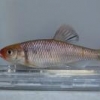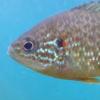I have a parasite that has affected my tank for at least two months. The parasite affects my pumpkinseed sunfish more than my other natives, but were found on my warmouth and northern longear before. Since the initial infestation, the longear and warmouth have shown no signs of the parasite. The bowfin in the tank have never been affected.
The parasite has only been found on the fins: The pectoral fins, caudal fin, anal fin, and soft dorsal have all been locations I have found the parasite. I have most recently found one under the "ear" of the gill cover of my largest pseed.
Most often they are white or slightly grayish in color. They move while on the fish and after I have removed them from the fish. The largest parasites are about 1-1.5 cm long. The most recent one I removed from the gill cover was whitish in color one day, then deep brown the next day when it was removed. This led me to believe the parasite was ingesting blood from the host.
I brought the above mentioned parasite in to my biology classroom and put it under the microscope. Based on what I can see and comparing with known fish parasites, it appears to be an annelid/leach.
I have treated with Prazipro a couple months ago, but apparently that did not eliminate this parasite.
Does anyone have a suggestion of how to treat if the parasite comes back (currently I do not see any parasites attached to any fish in that tank)?
I will try to attach pictures later.










